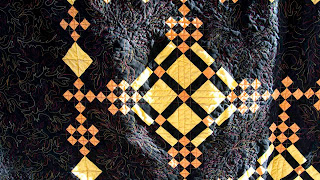We make a start with the most commonly use linking block - The Snowball. Harriet gives instruction on how to make this block. I cheated a bit and used my Marti Michell templates. Now I know I didn't rate these highly for making half square triangles, but for making Snowball blocks, they are definitely the way to go.
Cut your triangles with the templates, sew them directly onto your plain square, then trim off the excess. Brilliant!
Using the Snowball to connect a couple of 16 patch blocks
Next I had a go at Square in a Square. Very similar to Snowball but while Snowball has the corners of the square cut off, Square in a Square gets you the whole thing.
This time I used the Easy Angle to make my triangles
Sewing it the Harriet way
Square in a Square. Sorry not the best fabrics to use for this block, but you get the idea.
The book goes on to describe lots of other linking blocks and ideas for using them, then it was onto using pieced frames around your blocks. I'm sure I'll be making these a bit further along in the course, but for now it was a lesson in prettying up your sashings.
First up I made a Sawtooth Star Sashing. Once again I used the Perfect Patchwork templates in the same way as for the Snowball block.
Sew the little triangles to both ends of your sashing.........

add a linking square in the same colour as the triangles......
Voila! Sawtooth Star sashing.
Next up I had a go at Latticework Sashing.
Sew strips to both sides of your sashing......
Slice a square diagonally, then sew in a thin strip, cross over it with another strip appliqued over the top.
Use the square to join the two sashings.
Not really happy with this one. appliqueing the top strip is only one way to make this but I think I'd rather find a different way as I don't like how this looks.
Sorry about the tiny pics - for some reason Blogger won't let me adjust the size of any photos after the first few. It's kinda frustrating but I have no idea how to fix it.
So while I'm worried about putting together a pleasing design with pieced blocks, I have had a bit of a go with very simple designs and applique. There was this one I make for my 4 y.o. grandson who is motorbike mad.........
I've called it Jack Attack - you need to click on the image to see it properly.
I also made up a Cat Quilt for the end of my bed. I gave up putting quilts on my bed because they would very quickly be covered in cat fur. I decided to make a runner for the end of the bed where they like to sleep and made up my own design for it.
It fits rather nicely...but I still need to sew down the binding. Literally seconds after I lay this across the bed it was covered in cats, I had to fight them to get it back so I could finish it!
Anni and Floyd setting in :)
The applique cat designs came from pictures in "Cat Quilts & Crafts" by LaVera Langeman. LaVera allows free downloads of this out of print book from her blog. Thanks!
GETTING CREATIVE
I think Harriet has a point when she asks if creativity is becoming a lost art; when we buy other peoples designs, patterns, pre cut fabrics and kits, then simply sew up the top and have someone else do the quilting. What can I say - GUILTY!
I recently finished this beauty from a kit (at least I did the quilting myself)...............
It's called Vintage Valentine - designed by Verna Mosquera.
Now I can't imagine I could ever design anything as lovely as this and I still need lots of work in putting fabrics and colours together. So for now, I will continue to sew other peoples designs.
Still I will give this designing a shot.........Harriet promises it will be fun and I'm all set to get started.
Harriet recommends reading The It's Ok If You Sit On My Quilt Book by Mary Ellen Hopkins. I wasn't able to find a printed copy but managed to download an e-book version, so I'm good to go.






















































